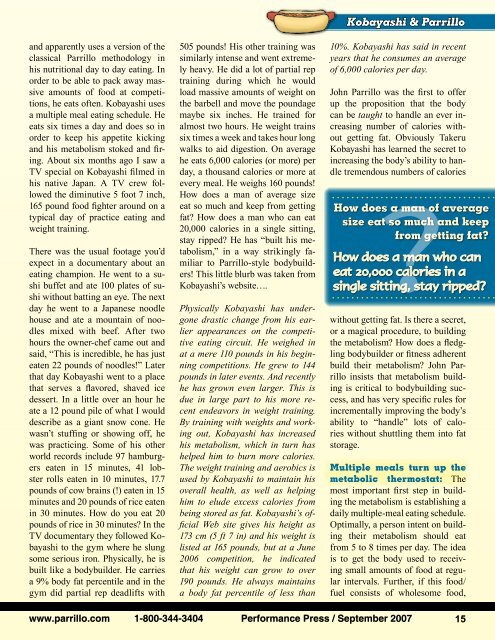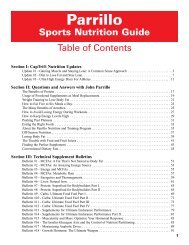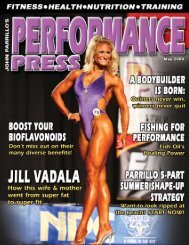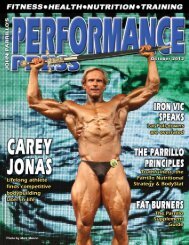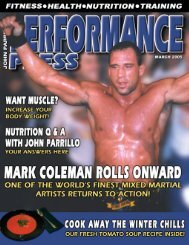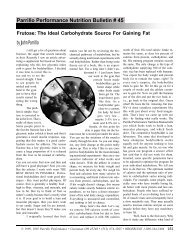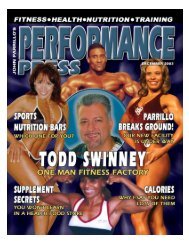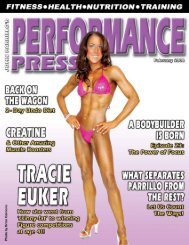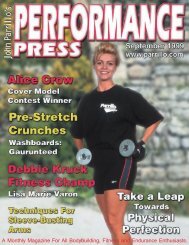Performance Press / September 2007 - Parrillo Performance
Performance Press / September 2007 - Parrillo Performance
Performance Press / September 2007 - Parrillo Performance
Create successful ePaper yourself
Turn your PDF publications into a flip-book with our unique Google optimized e-Paper software.
and apparently uses a version of the<br />
classical <strong>Parrillo</strong> methodology in<br />
his nutritional day to day eating. In<br />
order to be able to pack away massive<br />
amounts of food at competitions,<br />
he eats often. Kobayashi uses<br />
a multiple meal eating schedule. He<br />
eats six times a day and does so in<br />
order to keep his appetite kicking<br />
and his metabolism stoked and firing.<br />
About six months ago I saw a<br />
TV special on Kobayashi filmed in<br />
his native Japan. A TV crew followed<br />
the diminutive 5 foot 7 inch,<br />
165 pound food fighter around on a<br />
typical day of practice eating and<br />
weight training.<br />
There was the usual footage you’d<br />
expect in a documentary about an<br />
eating champion. He went to a sushi<br />
buffet and ate 100 plates of sushi<br />
without batting an eye. The next<br />
day he went to a Japanese noodle<br />
house and ate a mountain of noodles<br />
mixed with beef. After two<br />
hours the owner-chef came out and<br />
said, “This is incredible, he has just<br />
eaten 22 pounds of noodles!” Later<br />
that day Kobayashi went to a place<br />
that serves a flavored, shaved ice<br />
dessert. In a little over an hour he<br />
ate a 12 pound pile of what I would<br />
describe as a giant snow cone. He<br />
wasn’t stuffing or showing off, he<br />
was practicing. Some of his other<br />
world records include 97 hamburgers<br />
eaten in 15 minutes, 41 lobster<br />
rolls eaten in 10 minutes, 17.7<br />
pounds of cow brains (!) eaten in 15<br />
minutes and 20 pounds of rice eaten<br />
in 30 minutes. How do you eat 20<br />
pounds of rice in 30 minutes? In the<br />
TV documentary they followed Kobayashi<br />
to the gym where he slung<br />
some serious iron. Physically, he is<br />
built like a bodybuilder. He carries<br />
a 9% body fat percentile and in the<br />
gym did partial rep deadlifts with<br />
505 pounds! His other training was<br />
similarly intense and went extremely<br />
heavy. He did a lot of partial rep<br />
training during which he would<br />
load massive amounts of weight on<br />
the barbell and move the poundage<br />
maybe six inches. He trained for<br />
almost two hours. He weight trains<br />
six times a week and takes hour long<br />
walks to aid digestion. On average<br />
he eats 6,000 calories (or more) per<br />
day, a thousand calories or more at<br />
every meal. He weighs 160 pounds!<br />
How does a man of average size<br />
eat so much and keep from getting<br />
fat? How does a man who can eat<br />
20,000 calories in a single sitting,<br />
stay ripped? He has “built his metabolism,”<br />
in a way strikingly familiar<br />
to <strong>Parrillo</strong>-style bodybuilders!<br />
This little blurb was taken from<br />
Kobayashi’s website….<br />
Physically Kobayashi has undergone<br />
drastic change from his earlier<br />
appearances on the competitive<br />
eating circuit. He weighed in<br />
at a mere 110 pounds in his beginning<br />
competitions. He grew to 144<br />
pounds in later events. And recently<br />
he has grown even larger. This is<br />
due in large part to his more recent<br />
endeavors in weight training.<br />
By training with weights and working<br />
out, Kobayashi has increased<br />
his metabolism, which in turn has<br />
helped him to burn more calories.<br />
The weight training and aerobics is<br />
used by Kobayashi to maintain his<br />
overall health, as well as helping<br />
him to elude excess calories from<br />
being stored as fat. Kobayashi’s official<br />
Web site gives his height as<br />
173 cm (5 ft 7 in) and his weight is<br />
listed at 165 pounds, but at a June<br />
2006 competition, he indicated<br />
that his weight can grow to over<br />
190 pounds. He always maintains<br />
a body fat percentile of less than<br />
Kobayashi & <strong>Parrillo</strong><br />
10%. Kobayashi has said in recent<br />
years that he consumes an average<br />
of 6,000 calories per day.<br />
John <strong>Parrillo</strong> was the first to offer<br />
up the proposition that the body<br />
can be taught to handle an ever increasing<br />
number of calories without<br />
getting fat. Obviously Takeru<br />
Kobayashi has learned the secret to<br />
increasing the body’s ability to handle<br />
tremendous numbers of calories<br />
How does<br />
?<br />
a man of average<br />
size eat so much and keep<br />
from getting fat?<br />
How does a man who can<br />
eat 20,000 calories in a<br />
single sitting, stay ripped?<br />
without getting fat. Is there a secret,<br />
or a magical procedure, to building<br />
the metabolism? How does a fledgling<br />
bodybuilder or fitness adherent<br />
build their metabolism? John <strong>Parrillo</strong><br />
insists that metabolism building<br />
is critical to bodybuilding success,<br />
and has very specific rules for<br />
incrementally improving the body’s<br />
ability to “handle” lots of calories<br />
without shuttling them into fat<br />
storage.<br />
Multiple meals turn up the<br />
metabolic thermostat: The<br />
most important first step in building<br />
the metabolism is establishing a<br />
daily multiple-meal eating schedule.<br />
Optimally, a person intent on building<br />
their metabolism should eat<br />
from 5 to 8 times per day. The idea<br />
is to get the body used to receiving<br />
small amounts of food at regular<br />
intervals. Further, if this food/<br />
fuel consists of wholesome food,<br />
www.parrillo.com 1-800-344-3404 <strong>Performance</strong> <strong>Press</strong> / <strong>September</strong> <strong>2007</strong><br />
15


